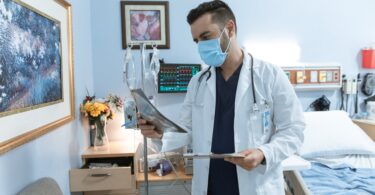
Healthcare
Healthcare facilities are complex environments that rely on specialized equipment to provide high-quality patient care. From diagnosis to treatment and monitoring, certain equipment is considered irreplaceable due to its critical role in delivering accurate diagnoses, facilitating life-saving procedures, and ensuring optimal patient outcomes. So read on as we explore 10 indispensable pieces of equipment that healthcare facilities cannot do without.
Thermometers
Our bodies possess a remarkable way of signaling when something is amiss. When our body temperature deviates from the norm, it is a warning sign that something is wrong. Temperature monitoring serves as a crucial diagnostic tool in healthcare. By using thermometers to track changes in body temperature, healthcare professionals can assess the severity of an illness, monitor the effectiveness of treatments, and make informed decisions regarding patient care.
Medical Carts
Medical carts are an indispensable asset in modern healthcare settings, providing flexibility and convenience for healthcare professionals. These carts offer mobility and easy transportation of medical supplies, enabling swift access to equipment, medications, and other essential items at the point of care. Moving supplies directly to the patient’s bedside or different areas of the facility enhances efficiency, saves time, and improves overall patient care.
These mobile medical carts, cabinets and storage systems offer efficient organization, ensuring that essential items are readily accessible when needed. From medication management to sterile instrument storage, well-designed storage solutions optimize workflow, reduce clutter, and minimize the risk of errors or delays in critical situations.
Wheelchairs
There are over 65 million people all over the world who use wheelchairs. Efficient transportation and transfers are critical for timely care and minimizing patient discomfort in a hospital setting. Wheelchairs offer a practical solution for safely and comfortably transporting patients between various departments, such as from the emergency room to diagnostic areas or from patient rooms to operating theaters.
Unfortunately, a recent incident in India shed light on the dire consequences of inadequate wheelchair access. A man had to take his son, who had a fracture, from the ground floor of a hospital to the third floor on his scooter because there was no wheelchair available. The incident stirred up much controversy, and the hospital received plenty of backlash from the public.
Diagnostic Imaging Systems
Diagnostic imaging systems, such as computed tomography (CT) scanners, X-ray machines, ultrasound devices, and magnetic resonance imaging (MRI) machines, provide detailed and precise images of the body’s internal structures. By capturing high-resolution images of bones, organs, tissues, and blood vessels, these systems assist healthcare professionals in identifying and diagnosing a wide array of conditions, including fractures, tumors, infections, and cardiovascular diseases.
Ventilators
Ventilators are indispensable tools in critical care settings. They act as a last resort when everything else fails. They are also used to provide breathing support for patients with respiratory problems. Many infants are born with breathing problems, and ventilators can help give these children a chance of survival.
Hospitals should have multiple ventilator beds, with separate accommodations for adults and infants. This allows healthcare providers to deliver targeted and specialized respiratory support to different age groups.
Blood Pressure Monitors
Hypertension affects around one billion people worldwide, and it is the number one risk factor for death! By using blood pressure monitors, healthcare professionals can assess an individual’s blood pressure levels and identify any abnormalities or persistent high readings that may indicate hypertension. If untreated, hypertension can lead to more severe illnesses like kidney damage, heart disease, and stroke.
Early detection and continuous blood pressure monitoring allow for timely intervention and the implementation of appropriate treatment strategies.
Defibrillators
Defibrillators are designed to restore normal heart rhythm in cases of ventricular fibrillation and pulseless ventricular tachycardia, which are life-threatening cardiac arrhythmias. These devices deliver a precisely timed electric shock to the heart, momentarily stopping its electrical activity and allowing its natural pacemaker to reset and reestablish an organized rhythm. This prompt intervention is crucial in preventing sudden cardiac death and increasing the chances of survival. In fact, statistics show that if a defibrillator is used within the first 3-5 minutes of cardiac arrest, it can boost the victim’s survival rates from 6% to 74%!
Every minute without defibrillation decreases the chances of survival by 7-10%. By having defibrillators readily available in hospitals, public spaces, and ambulances, healthcare providers can initiate immediate life-saving measures. Early defibrillation combined with CPR forms the foundation of the “Chain of Survival” and is vital for increasing survival rates.
Gloves
Latex and vinyl gloves are indispensable tools in healthcare facilities, providing a crucial protection barrier for healthcare professionals and patients. By wearing gloves, healthcare workers can significantly reduce the risk of cross-contamination, protecting themselves and patients from transmitting harmful pathogens.
Autoclaves
The principle behind autoclaves is deceptively simple yet highly effective. The machine uses pressurized steam to raise the temperature inside a sealed chamber, effectively killing microorganisms.
In healthcare settings, autoclaves are used to sterilize various items, including surgical instruments, glassware, textiles, and even reusable medical devices. Autoclaves are found in operating rooms, dental clinics, laboratories, and other areas where maintaining a sterile environment is paramount.
What makes autoclaves even more remarkable is their versatility. Autoclaves come equipped with programmable settings, allowing healthcare professionals to adjust parameters such as temperature, pressure, and cycle duration to meet specific sterilization requirements.
Anesthesia Machines
Anesthesia has completely revolutionized healthcare. Before anesthesia, assistants held screaming patients down on wooden benches while doctors cut into their skin. In such circumstances, accidents were bound to happen, with devastating consequences. Once, a doctor inadvertently sliced through an assistant’s fingers, leading to a disastrous chain of events. The patient succumbed to infection, and tragically, the assistant met the same fate. To add to the chaos, an observer in the room, overwhelmed by shock, passed away too. It has to be the only surgery in history with a 300% mortality rate.
Thankfully, the advent of anesthesia has liberated patients from such agony. Anesthesia machines help deliver precise amounts of anesthetic gases, oxygen, and medications, allowing patients to remain unconscious and pain-free during surgery. Anesthesia machines incorporate advanced monitoring capabilities to ensure patient safety and enable healthcare professionals to make real-time adjustments.
Conclusion
The 10 irreplaceable pieces of equipment discussed above represent only a fraction of the essential tools healthcare facilities rely on to deliver optimal care. So, the next time you find yourself in a healthcare facility, take a moment to appreciate these marvelous contraptions and the dedicated professionals who wield them.






